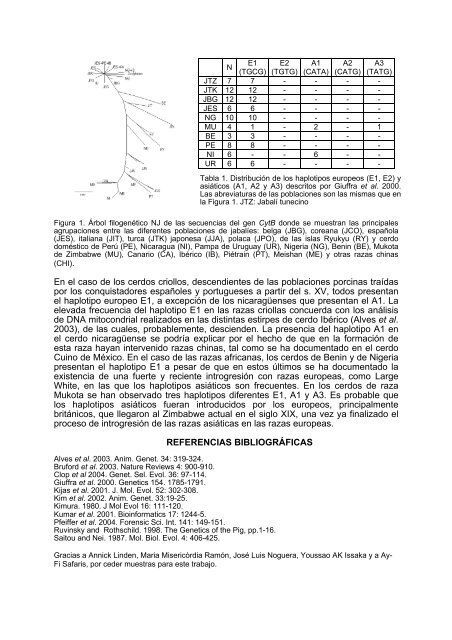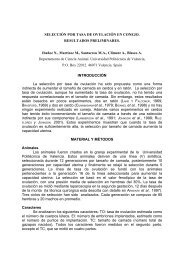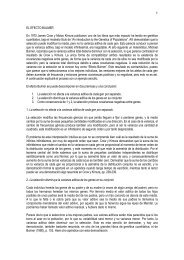análisis mitocondrial del jabalí y de razas porcinas ... - acteon
análisis mitocondrial del jabalí y de razas porcinas ... - acteon
análisis mitocondrial del jabalí y de razas porcinas ... - acteon
You also want an ePaper? Increase the reach of your titles
YUMPU automatically turns print PDFs into web optimized ePapers that Google loves.
Figura 1. Árbol filogenético NJ <strong>de</strong> las secuencias <strong><strong>de</strong>l</strong> gen CytB don<strong>de</strong> se muestran las principales<br />
agrupaciones entre las diferentes poblaciones <strong>de</strong> <strong>jabalí</strong>es: belga (JBG), coreana (JCO), española<br />
(JES), italiana (JIT), turca (JTK) japonesa (JJA), polaca (JPO), <strong>de</strong> las islas Ryukyu (RY) y cerdo<br />
doméstico <strong>de</strong> Perú (PE), Nicaragua (NI), Pampa <strong>de</strong> Uruguay (UR), Nigeria (NG), Benin (BE), Mukota<br />
<strong>de</strong> Zimbabwe (MU), Canario (CA), Ibérico (IB), Piétrain (PT), Meishan (ME) y otras <strong>razas</strong> chinas<br />
(CHI).<br />
En el caso <strong>de</strong> los cerdos criollos, <strong>de</strong>scendientes <strong>de</strong> las poblaciones <strong>porcinas</strong> traídas<br />
por los conquistadores españoles y portugueses a partir <strong><strong>de</strong>l</strong> s. XV, todos presentan<br />
el haplotipo europeo E1, a excepción <strong>de</strong> los nicaragüenses que presentan el A1. La<br />
elevada frecuencia <strong><strong>de</strong>l</strong> haplotipo E1 en las <strong>razas</strong> criollas concuerda con los <strong>análisis</strong><br />
<strong>de</strong> DNA <strong>mitocondrial</strong> realizados en las distintas estirpes <strong>de</strong> cerdo Ibérico (Alves et al.<br />
2003), <strong>de</strong> las cuales, probablemente, <strong>de</strong>scien<strong>de</strong>n. La presencia <strong><strong>de</strong>l</strong> haplotipo A1 en<br />
el cerdo nicaragüense se podría explicar por el hecho <strong>de</strong> que en la formación <strong>de</strong><br />
esta raza hayan intervenido <strong>razas</strong> chinas, tal como se ha documentado en el cerdo<br />
Cuino <strong>de</strong> México. En el caso <strong>de</strong> las <strong>razas</strong> africanas, los cerdos <strong>de</strong> Benin y <strong>de</strong> Nigeria<br />
presentan el haplotipo E1 a pesar <strong>de</strong> que en estos últimos se ha documentado la<br />
existencia <strong>de</strong> una fuerte y reciente introgresión con <strong>razas</strong> europeas, como Large<br />
White, en las que los haplotipos asiáticos son frecuentes. En los cerdos <strong>de</strong> raza<br />
Mukota se han observado tres haplotipos diferentes E1, A1 y A3. Es probable que<br />
los haplotipos asiáticos fueran introducidos por los europeos, principalmente<br />
británicos, que llegaron al Zimbabwe actual en el siglo XIX, una vez ya finalizado el<br />
proceso <strong>de</strong> introgresión <strong>de</strong> las <strong>razas</strong> asiáticas en las <strong>razas</strong> europeas.<br />
REFERENCIAS BIBLIOGRÁFICAS<br />
Alves et al. 2003. Anim. Genet. 34: 319-324.<br />
Bruford et al. 2003. Nature Reviews 4: 900-910.<br />
Clop et al 2004. Genet. Sel. Evol. 36: 97-114.<br />
Giuffra et al. 2000. Genetics 154. 1785-1791.<br />
Kijas et al. 2001. J. Mol. Evol. 52: 302-308.<br />
Kim et al. 2002. Anim. Genet. 33:19-25.<br />
Kimura. 1980. J Mol Evol 16: 111-120.<br />
Kumar et al. 2001. Bioinformatics 17: 1244-5.<br />
Pfeiffer et al. 2004. Forensic Sci. Int. 141: 149-151.<br />
Ruvinsky and Rothschild. 1998. The Genetics of the Pig, pp.1-16.<br />
Saitou and Nei. 1987. Mol. Biol. Evol. 4: 406-425.<br />
N<br />
E1<br />
(TGCG)<br />
E2<br />
(TGTG)<br />
A1<br />
(CATA)<br />
A2 A3<br />
(CATG) (TATG)<br />
JTZ 7 7 - - - -<br />
JTK 12 12 - - - -<br />
JBG 12 12 - - - -<br />
JES 6 6 - - - -<br />
NG 10 10 - - - -<br />
MU 4 1 - 2 - 1<br />
BE 3 3 - - - -<br />
PE 8 8 - - - -<br />
NI 6 - - 6 - -<br />
UR 6 6 - - - -<br />
Tabla 1. Distribución <strong>de</strong> los haplotipos europeos (E1, E2) y<br />
asiáticos (A1, A2 y A3) <strong>de</strong>scritos por Giuffra et al. 2000.<br />
Las abreviaturas <strong>de</strong> las poblaciones son las mismas que en<br />
la Figura 1. JTZ: Jabalí tunecino<br />
Gracias a Annick Lin<strong>de</strong>n, Maria Misericòrdia Ramón, José Luis Noguera, Youssao AK Issaka y a Ay-<br />
Fi Safaris, por ce<strong>de</strong>r muestras para este trabajo.






